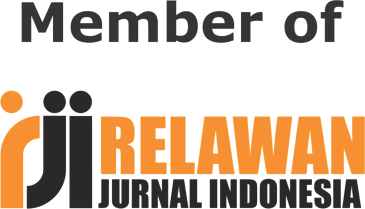Spatial Mapping of Landslide Susceptibility Level in Pacitan District Using Analytical Hierarchy Process and Natural Break
Abstract
Pacitan district has a high potential for landslides. Landslide is a hydrometeorological disaster that causes loss of life, property loss, and environmental damage. Disaster preparedness is very necessary for the wider community in dealing with landslide emergency response situations. Applications to determine the level of vulnerability to landslides are very useful to minimize the impact and losses on the Pacitan community. This study aims to make an application for assessing the level of landslide susceptibility using the analytical hierarchy process and natural break based on the factors that cause landslides in the sub-district or village of Pacitan district. The factors that cause landslides in Pacitan district consist of weather, history of landslides, land slope, and history of earthquakes. The results of the AHP and natural break classifications are visualized in the form of a spatial map into 3 categories, namely high, medium and low vulnerability levels. The results of the AHP classification and natural break in the 2016-2020 data have a good average GVF value of 0.77. This shows that in general, the results of the 2016-2020 data classification are correct. Mobile device-based applications provide convenience for the public in accessing information as an effort to improve landslide disaster preparedness.
Downloads
References
M. A. Khafid, “Analisis Penentuan Zonasi Pemukiman Risiko Bencana Tanah Longsor Berbasis Sistem Informasi Geografis: Studi Kasus Kecamatan Gedangsari, Kabupaten Gunung Kidul, Daerah Istimewa Yogyakarta”, Jurnal Meteorologi Klimatologi Dan Geofisika, vol. 6, no.1, pp. 49-57, 2019.
A. Rosyida, R. Nurmasari, “Analisis Perbandingan Dampak Kejadian Bencana Hidrometeorologi dan Geologi di Indonesia Dilihat Dari Jumlah Korban (Studi: Data Kejadian Bencana Indonesia 2018)”, Jurnal Dialog dan Penanggulangan Bencana, vol. 10, no. 1, pp. 12-21, 2019.
H. K. Rahmat, H. Pratikno, F. A. I.Gustaman, D. Dirhamsyah, “Persepsi Risiko dan Kesiapsiagaan Rumah Tangga dalam Menghadapi Bencana Tanah Longsor di Kecamatan Sukaraja Kabupaten Bogor”, SOSIOHUMANIORA: Jurnal Ilmiah Ilmu Sosial dan Humaniora, vol. 6, no. 2, pp. 25-31, 2020.
P. D. Susanti, A. Miardini, “Identifikasi Karakteristik dan Faktor Pengaruh pada Berbagai Tipe Longsor”, agriTECH, vol. 39, no. 2, pp. 97-107, 2019.
Badan Nasional Penanggulangan Bencana, “Data Informasi Bencana Indonesia”, tersedia di https://dibi.bnpb.go.id/xdibi, diakses pada tanggal 27 Januari 2022.
B. M. Faturahman, “Strategy of emergency response of flood and landslide disaster in pacitan regency”, Jurnal Ilmu Administrasi: Media Pengembangan Ilmu dan Praktek Administrasi, vol. 15, no. 2, pp.133-147, 2018.
N. Dzakiya, R. A. Hidayah, L. Larikiansyah, “Analisis Potensi Longsor Menggunakan Metode Geolistrik Konfigurasi Dipole-dipole di Desa Kasihan Kecamatan Tegalombo Kabupaten Pacitan Jawa Timur”, Jurnal Materi dan Pembelajaran Fisika, vol. 8, no. 2, pp. 17-22, 2018.
R. A. Hidayah, N. Dzakiya, “Analysis Geological and Geophysical Data for Prediction Landslide Hazard Zone with Weight of Evidence Method in Pacitan District East Java”, Journal of Applied Geospatial Information, vol. 2, no. 1, pp. 117-123, 2018.
A. Yalcin, “GIS-Based Landslide Susceptibility Mapping Using Analytical Hierarchy Process and Bivariate Statistics In Ardesen (Turkey): Comparisons of results and confirmations”, CATENA, vol. 72, no. 1, pp. 1-12, 2008.
N. Ismayani, F. Ferawati, H. Febrianto, “Studi Karakteristik lahan pada kawasan rawan longsor di Kecamatan Koto Parik Gadang Diateh Kabupaten Solok Selatan”, Jurnal Georafflesia: Artikel Ilmiah Pendidikan Geografi, vol. 6, no. 1, pp. 58-67, 2021.
B. Feizizadeh, T. Blaschke, “GIS-multicriteria decision analysis for landslide susceptibility mapping: comparing three methods for the Urmia lake basin, Iran”, Nat Hazards, vol. 65, pp. 2105–2128, 2103.
R. Kumar, R. Anbalagan, “Landslide susceptibility mapping using analytical hierarchy process (AHP) in Tehri reservoir rim region, Uttarakhand”, Journal of the Geological Society of India, vol. 87, no. 3, pp. 271-286, 2016.
A. Basofi, A. Fariza, A. S. Ahsan, I. M. Kamal, “A comparison between natural and Head/tail breaks in LSI (Landslide Susceptibility Index) classification for landslide susceptibility mapping: A case study in Ponorogo, East Java, Indonesia”, In 2015 International Conference on Science in Information Technology (ICSITech) (pp. 337-342). 2015. IEEE.
R. P. Pratama, “Application of GIS for the mapping of landslide-vulnerable areas by through android-based Analytical Hierarchy Process (AHP) method in Bantul Regency”, In IOP Conference Series: Earth and Environmental Science, vol. 245, no. 1, pp. 012008, 2019.
I. M. Hanif, G. Ikhwanushova, “Geographic information system (GIS) analysis for landslide risk potential zonation using analytical hierarchy process (AHP) at Tunggilis area, Pangandaran, Indonesia”, In AIP Conference Proceedings, vol. 1987, no. 1, pp. 020069, 2018, July.
J. Chen, S. Yang, H. Li, B. Zhang, J. Lv, “Research on geographical environment unit division based on the method of natural breaks (Jenks)”, Int. Arch. Photogramm. Remote Sens. Spat. Inf. Sci, vol. 3, 47-50. 2013.
Copyright (c) 2022 Digital Zone: Jurnal Teknologi Informasi dan Komunikasi

This work is licensed under a Creative Commons Attribution-ShareAlike 4.0 International License.












